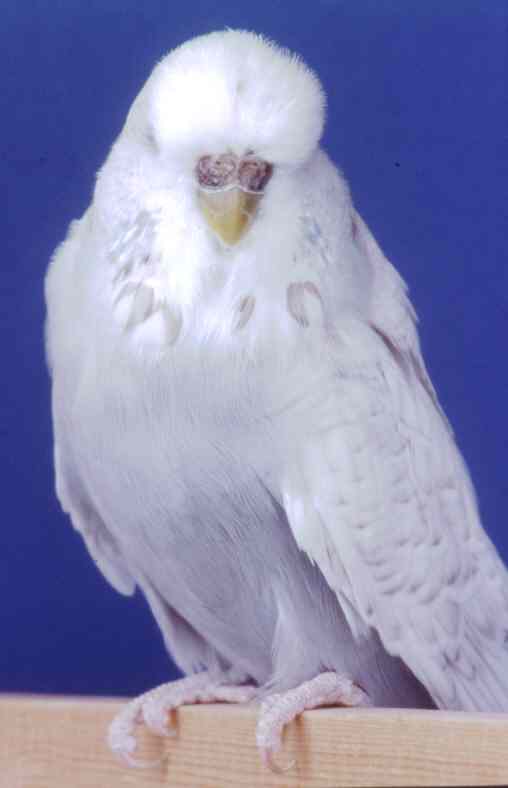
JUDGING THE SPANGLE VARIETY
by Ghalib Al-Nasser
(Photo. Spangle Cinnamon Grey hen bred by G & J Al-Nasser)

|
JUDGING THE SPANGLE VARIETY (Photo. Spangle Cinnamon Grey hen bred by G & J Al-Nasser) |
|
This article is based on a lecture given by Ghalib Al-Nasser at the 1999 Annual Judges Meeting.
In March 1994 The Budgerigar Society (B.S.) introduced that wonderful 'Bible' the Colour Standards. This updated version had a number of new innovations, which included the British written standard for the Spangle Variety, and a new grading of the Scale of Points.
The B.S. has seen wisdom and merit in that more attention should be paid to the "variety marking" of the Budgerigar and not only consider size. Because if size was the only criteria to consider then there is no point in having a classification for shows which cater for 18 different colour groups. Take this point to the extreme we can just have 4 classes only (Any Age cock & hen and Young Bird cock & hen). Yes, this is an extreme case and rather silly.
The new Scale of Points is still geared towards the size of the bird (60 points instead of 65 points in the old standard) but what the B.S. is telling us now is to look more closely at the variety marking of the bird which has 25 points allocated to it.
Our system of judging is not based on the Points system but that Scale of Points is there to assist us at the final decision-making.
We, the Budgerigar Society Panel Judges, are the custodians of these Colour Standards as laid down to us by the B.S. and we should uphold these Standards. Or should we!!!
So let us now consider the various features of the Spangle and look at the Guidelines that the B.S. have asked us to adhere to and see whether we should deviate from them. Let us first consider the Normal Single Factor Spangle.
SPOTS
The description of the spots as per our Bible is that they should be "six evenly spaced large round black throat spots with yellow (or white) centres".
The B.S. Guidelines to Judges and Exhibitors tell us that deviations from the Standard should be penalised: incomplete or absent throat spots.
Over the years we have seen many Spangles of super quality winning their Challenge Certificates (C.C.’s) and even major specials including BIS but without spots. Most probably some of us here today have been involved with such decisions.
Of course those who have made such decisions will be in that group with the school of thought, which many consider that size is the only criteria when judging a bird. Shouldn't the 25 points for variety marking play its part here? Would you ever consider a really top class super Green or Blue for a C.C. or a major award if the bird did not posses spots? I don't think so. So why do some of us not apply the same logic when it comes to Spangles?
You could also argue the case that Spangles with solid black spots are incomplete in as far as the spot description as per our Standards, and even the type of spots that we see on most Spangles; I refer to the pair of brackets type.
MARKINGS
Again our Bible tells us that the wing markings should be "each feather buttercup yellow (or white) edged with black plus a further buttercup yellow (or white) edge". The Guidelines tell us that we should penalise Spangles with completely black feathers on the wing.
If we apply the Standards and the 25 points for variety markings in the Scale of Points then we should penalise Spangles with just faint wing marking regardless of their quality.
Another problem we are facing with some Spangles in their appearance with a Dominant Pied head patch. Although history tells us that Pieds were involved in the Spangle production, the Colour Standards has made no allowance for history unfortunately. So should Spangles with head patch win on the show bench because of the bird's quality?
I know we judges face dilemmas all the time and judging Spangles can be such a dilemma. If we put variety markings ahead of size and shape we will be criticised for not appreciating a good budgie. However, if we favoured size and shape as most, if not all, of us do over variety markings we still are criticised for not knowing what a good Spangle is.
Another dilemma Spangle breeders face is that what might be a good Spangle marked bird in its first year or two could loose the black sharpness after successive moults.
Let us now consider the Double Factor Spangle and there have been some super ones around winning best in show at top shows.
The Standards say that the bird should be "free from any odd green feathers or green suffusion, which is the ideal but slight collar of colour round the neck, is acceptable". Of course the same applies to the Blue series, the Double Factor Spangle White.
The Guidelines further emphasise the faults in Double Factor Spangles, as "Any black or grizzled ticking visible anywhere on the bird or green, blue or grey suffusion should be penalised".
Some judges, as well as exhibitors, have made comments over the years on how you can judge a Double Factor Spangle, a bird without any marking, against a Single Factor Spangle a bird with body colour and marking.
Ladies and gentlemen can I ask you on how you can judge best in show from a line up of 18 different colour groups or your best in section from twice that amount. At all times you are applying the written words of each individual variety together with the scale of points even though you do that subconsciously.
Remember one easy way of telling the difference between a Double Factor Spangle and a Dark-eyed Clear is that with cocks the cere and beak is the colour difference and the eye, and with hens is the beak and the eye.
OPALINE & CINNAMON SPANGLES
Within the Spangle Colour Standards there is a note telling us that Spangles can be combined with all other varieties except the Dark-eyed Clear. The most other common Spangle varieties we see on the show bench are the Opaline and Cinnamon versions.
With the Opaline Spangle, the black edging on each feather is placed on a body colour ground and symmetrically shaped with an opalescent effect. That is the effect of the Opaline on the Spangle so do not penalise Opaline Spangles because of your preference to Normal Spangles.
With the Cinnamon Spangles all the black marking reference in the Standards is replaced with cinnamon brown.
However, with Cinnamon Spangles we still need to see the well define cinnamon brown in the spots and the wing marking.
If with some Cinnamon Spangles the wing marking and the spots become so faint that you can hardly see the marking then here is another case whereby you can apply the 25 points variety markings into the equation.
Try not to penalise Spangles that are well marked Opalines or Cinnamons and treat them as you do with Normal Spangles but of course penalise them if they are badly marked.
Some of the Cinnamon Spangles we see on the show bench, our Clearwing breeders would love to have that clarity of wings on their Clearwings. Do not just ignore this fault and say well they are Cinnamons. Yes they are Cinnamons but still they have to adhere to the cinnamon marking.
The B.S. has written a Provisional Standard for the Opaline and Cinnamon Spangles, which hopefully will be published in due course.
Remember also the order of priority as laid down by the B.S. as all Spangles have to be shown in the Spangle classes with the exception of the Crested Spangle which will have to be shown in the Crested classes.
My talk on the Spangle variety is based on the BS Standards and it is up to you to uphold these Standards. Thank You.
Spangle Review
Issue No. 24 ~ Winter 1999